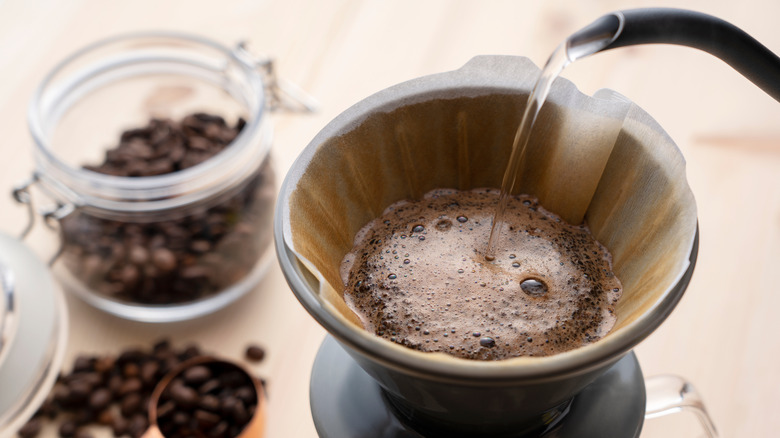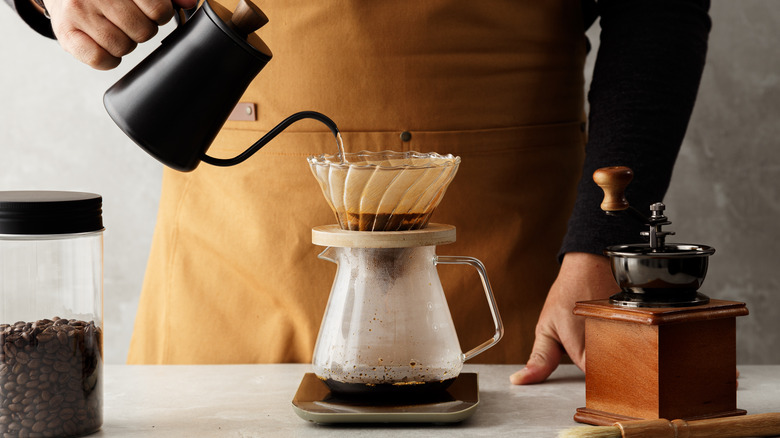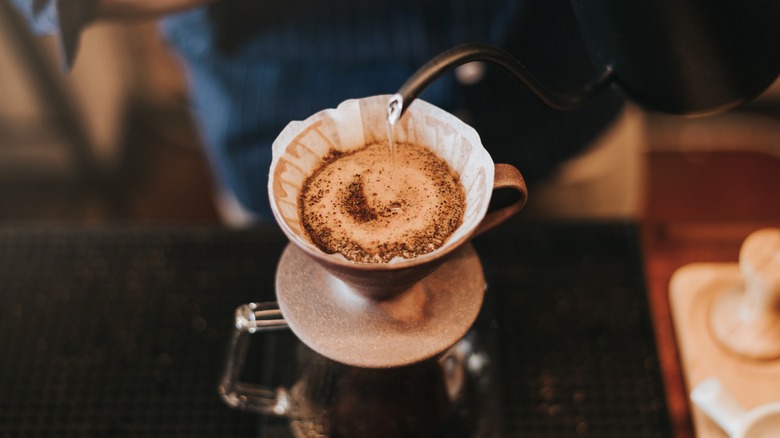What Does It Mean To 'Bloom' Your Coffee?
We may receive a commission on purchases made from links.
There are many fine details to the art of coffee-making, but all of them are worth your attention to achieve that elusive perfect cup. One such nuance that should not be overlooked is remembering to let your coffee bloom. It might sound like a gimmicky hack, but it's backed by science and helps you enjoy the subtle characteristics of your brew. This is important because not only does the United States still run on coffee since the 1770s (per Public Broadcasting Network), both its price and consumption are projected to keep increasing, according to Business Insider. There's no reason to be choking down bitter, watery, or off-tasting coffee when there's such a rich sensory experience waiting to blossom from those roasted beans.
But they can't do it alone. Coffee needs TLC, and it can get it through the pour-over method dating back to 1908 (via Eight Ounce): Widely beloved by coffee lovers as an intimate way to enjoy coffee by the cup. It takes a while, so if your household needs coffee in the morning, you might want to stick with a coffee maker or order it on your way to work. But all you'll need is some basic equipment: A teapot, a pour-over cone (or brewer/maker carafe), an appropriate filter, your coffee, and your favorite mug. This low-tech way to make coffee is what's behind the bloom.
Pour-over coffee prep
CNN interviewed several coffee experts, including roaster Colby Cox from Atlas Coffee Club, on executing an exemplary pour-over. He suggests 1 ounce of coffee for every 16 ounces of water you intend to imbibe. Cox and his colleagues recommend good-quality water from about 195 to 208 degrees Fahrenheit and freshly ground, quality coffee prepared in a burr grinder, which permits an even grind and ensures maximum freshness and flavor, according to The New York Times's Wirecutter. If you don't have the kind of kettle that indicates temperature, Maciej Kasperowicz of Trade tells us to use the water 30 seconds or so after boiling it.
While you can pull off a pour-over with any teapot or even a standard electric kettle with some dexterity, using a specialized pour-over teapot (or gooseneck kettle) helps you maintain control of the water flow for even distribution among the grinds. They come in electric and stove-top versions, according to Methodical Coffee. There are additional but optional items like ceramic brew or metal cones and rails for simultaneous pour-overs and precision scales and timers. There are even pour-over recipes like Connan Moody's with pears, honey, spices, and sweet wine. It's as sophisticated as you want it to be!
Pour-over coffee method and bloom
Single-serve pour-over coffee calls for a cone apparatus situated over your mug lined with a filter that holds your ground coffee. Larger-capacity pour-over coffee makers like Bodum's popular model from Amazon utilize a reusable stainless steel filter. Start by adding your coffee grounds evenly to the filter, tapping lightly if necessary. Add a little bit of water and let it sit until bubbles have formed — which is the coffee releasing carbon dioxide gas from the roasting process, per CNN. This is the bloom. The Roaster's Pack explains that the released gas is replaced by water, thus initiating the extraction process — in other words, becoming coffee. They add that bloom indicates fresh, recently ground, and properly-stored coffee.
The next step is subject to some debate, but it always involves adding water until your mug is filled with the best coffee you've ever tasted. Some of CNN's interviewees pour enough water to fill their cone to half-capacity, drain it, and do it again. Others add progressively less water per pour or even move the cone around while the water soaks the grounds. For such a simple-sounding technique, there's plenty of room for artistry. Armed with such java knowledge, you can use your poured-over brew in recipes like Irish coffee, Vermont coffee, and coffee pot roast. A perfect cup might be just the thing to perk up your cooking.


